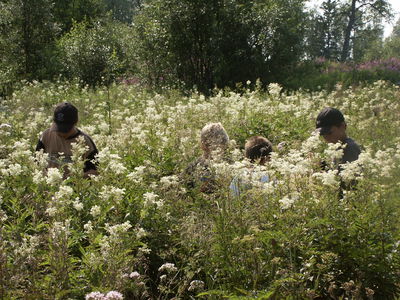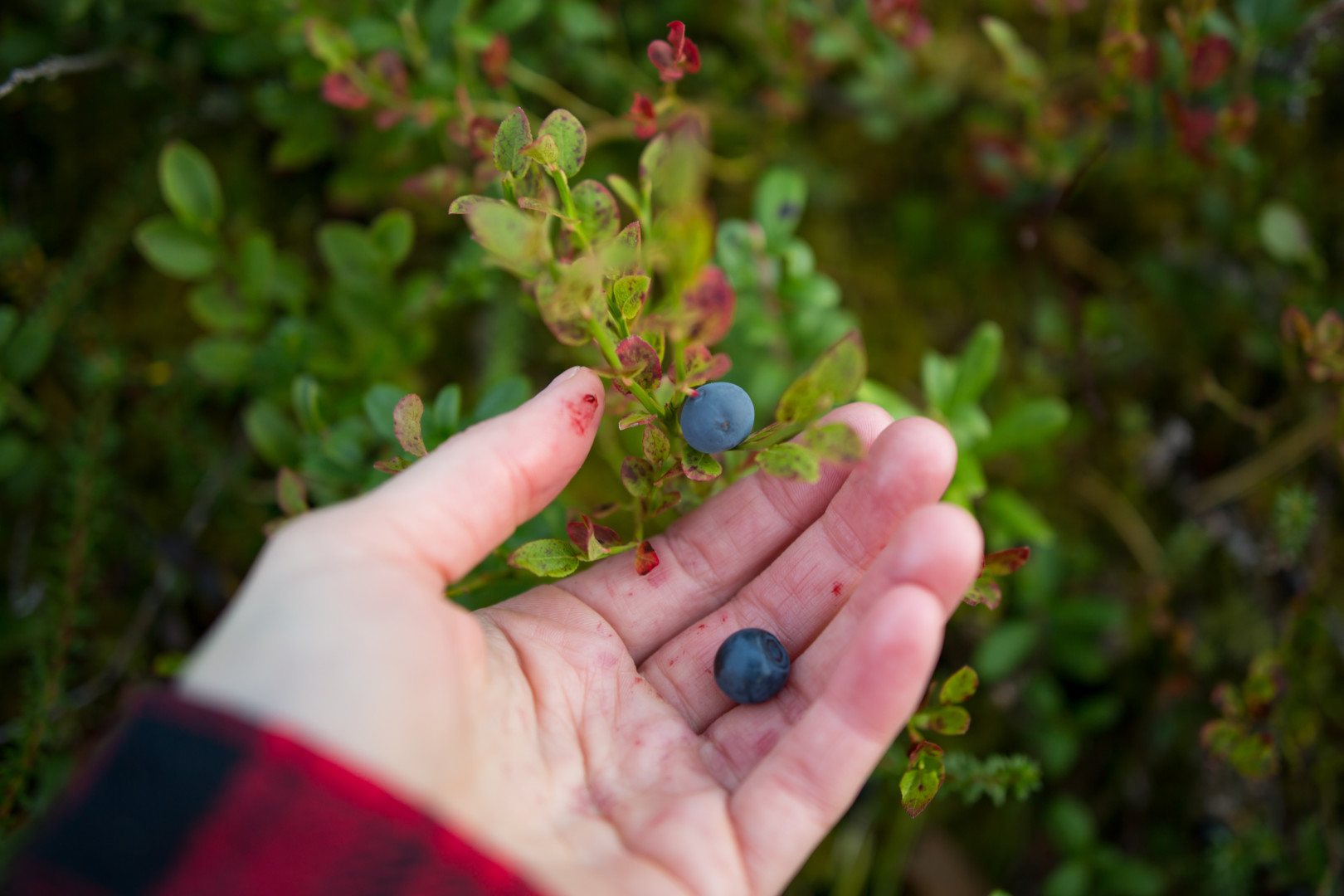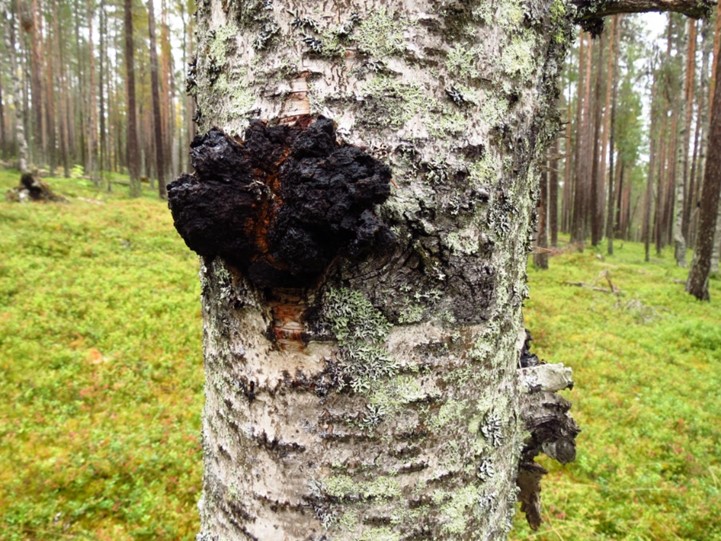The forests in the Arctic region produce not only timber. In the northern parts of Norway, Sweden and Finland, we have a very strong culture of utilizing the wild resources in the forest and mountains. Also today, use of various forest products such as wild berries and mushrooms is part of the life of practically everyone. It is not unusual that most of them we pick ourselves to our families, and luckily there are people who can earn some extra money by picking berries for their family neighbours and friends. When it comes to products like sap, resin, chaga, and herbs, we have specialised SME:s who have the ability to refine them.

Collecting filipendula ulmaria. Photo Detria / Eija Vuorela
Non-timber forest products (NTFP) is a widely known concept by which is generally meant berries, mushrooms growing on the ground and on trees, resins, various kinds of natural products that grow in forests. The legal concept of “Everyman’s Right” in Finland… pick wild berries, mushrooms and flowers, as long as they are not protected species (this can be restricted or forbidden in national parks and other nature reserves during certain seasons or year-round) The written and informal rules are to a large extent similar in Norway.
Harvest every year!
While a tree grows for maybe decades before it can be eco-efficiently used for timber products, many of the non-timber forests species grow and are ready for utilization in the meantime. Some of them (e.g. berries) can be picked every year. Domestic use of them is everyday life, and selling berries gives an extra income to many. Many of the NTFP that are on the focus of the project, are already utilized on the markets.
The availability of the products is insecure. You never know when and where they grow. How good is the harvest this year? This is one of the reasons why SMEs are interested in the NTFP business only to a certain extent.
The project Agroforestry in Barents Region has worked on potential methods how humans can enhance and control their growth – this is agroforestry.
The objective of the project is to combine agricultural and forestry technologies aiming to create profitable, healthy, ecologically sound and sustainable land-use systems for improved availability of NTFP raw materials in Barents region. Agroforestry is always governed, target – oriented concept in which investments are used or alternative costs are accepted in order to achieve the most profitable output.
One interesting part of the project is piloting of agroforestry practices. In the task division in the project, the Norwegian Institute of Bioeconomy Research is responsible for it. The participating organisations all are experienced in field testing, and in this project they have combined their strengths in testing. It is then also possible to compare results in different testing areas and in different habitats – in different countries.
Bilberry – a long-term favourite

Bilberry is one of the species in the project. It is a desired berry because of its taste and healthiness, but the availability varies a lot. It is not exceptional to see 3- 4 fold differences in the amount of bilberries in subsequent years. The growth of bilberry and methods to control it is tested in the project.
Chaga, the hit of recent years

Chaga mushroom (Innotus obliquus) growing on a birch tree. Photo: Marja Keskitalo, Natural Resources Institute Finland
Not all forests and trees are suitable for sustainable timber production. Where the circumstances are appropriate, the production of chaga mushroom may be one alternative. Chaga is a success among health products. Natural Resources Institute Finland especially has promoted knowledge on Chaga, and it is one species that the project has involved in their field tests.
To whom does the NTFP belong?
The project also paid attention to the problematics of combining everyman’s right and agroforestry. How to combine investments in agroforestry and, on the other hand, the freedom of citizens to utilize the output of it? This is a puzzle which is still to be solved.
Bjørn Egil Flø in NIBIO, Norway, has studied the socioeconomic aspects of agroforestry. It is, how economic activity, in this case use of non-timber forest products, affects, and is shaped by, social processes. The written and non-written laws and rules about utilizing forest NTFP have evolved in Norway, Sweden, and Finland over centuries, by people agreeing on the best practices.
One interesting thing, says Bjørn Egil Flø, is that in history, from the state perspective, it was important to settle the land here to claim the National ownership and agree upon the borders towards the neighbouring countries. The communities in the north were remote, and the climate was harsh. “Therefore the state provided support for people to settle and cultivate the land. It was a welfare issue to give local people access to the resources in the outfield” says Bjørn Egil Flø.
The applying of everyman’s right has not always been self-evident and the interpretations have varied.
Agroforestry as a tool of rural development
Bjørn Egil Flø has compiled the conditions for agroforestry as a rural development tool.
First we have to ensure that it is
- embedded in local recourses as well as history, skills and knowledge.
Second we need to secure
- local ownership, both to the recourses as well as to the means of production and the values created by the production
Third we need
- local engagement, we need to stimulate and facilitate potential entrepreneurs both economically as well as trough counselling and training and other services.
And finally we need good old-fashion
- endogenous approaches
Project: Agroforestry in Barents Region
Lead partner: Lapland University of Applied Sciences, Rovaniemi
Other partners:
*Northern Arctic Federal University, Arkhangelsk
*Natural Resources Institute Finland, Helsinki
*Norwegian Institute of Bioeconomy Research, Tromsø
